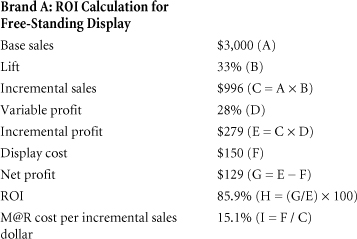10. Measuring Return on Investment
Delivering Results
Dynamic Tensions
Retail marketing is an art and a science. The scientific part of the equation includes segmenting and analyzing shoppers, defining performance drivers, and composing precise mathematical equations that measure and predict performance. The art comes into play in implementing those strategies so that they deliver the desired results.
Retail campaign optimization requires the careful navigation of a series of dynamic tensions that require careful strategy development. These dynamic tensions are double-edged swords—an overly conservative approach limits the number of shoppers visiting our stores or sections and suboptimizes the value of the traffic we generate; an overly aggressive implementation likewise restricts traffic and constrains the size of the potential shopping basket. We need to recognize and understand these tensions to properly balance our program planning.
The tensions begin with our modern shopper. Although she is unbelievably empowered with access to information and products unimaginable a few years ago, the price of this empowerment is overload. However, the intrusion of media and uninterrupted access to work and family results in a loss of personal time and increased stress levels (see Figure 10.1).
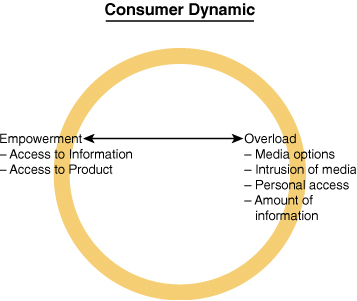
Within the retail environment, store layout represents a significant point of strategic tension affecting shopper navigation (see Figure 10.2). We know that sales are linked to the distance traveled in store. However, traffic into the store is influenced by convenience. Although we want to maximize the areas of the store visited for those shoppers engaged in a main shopping trip that requires them to visit the entire store, we also want to deliver sufficient convenience for fill-in trips so that we attract the maximum number of visits. We want to make our store the best option for shoppers completing their personal value equations and calculating the likely effort required to complete their mission. Strategically, location of sections within the store and adjacencies are the tools we can employ to optimize the value to our targeted shoppers.
The second retail challenge involves assortment; we need to balance the convenience of providing many categories against the depth of product choices required to sustain credibility as a preferred destination. The tension in assortment is exacerbated by the desire to generate sufficient SKU productivity to support net profit objectives (see Figure 10.3). The old general store pursued a philosophy of broad categories and narrow item options because it was required to meet the broad needs of its community, and shoppers lived with minimal shopping options. Today, the middle ground is a no man’s land of mediocrity on a path to extinction. Success comes on the peripheries, with successful strategies including
• Narrow category presentation and a deep level of item choices; that is, category specialists such as an REI
• Broad product assortments with narrow product offerings, such as deep discounters like Aldi and warehouse clubs
• Broad categories with deep offerings, such as hypermarkets and supercenters
Figure 10.2 Retail Dynamic-Navigation
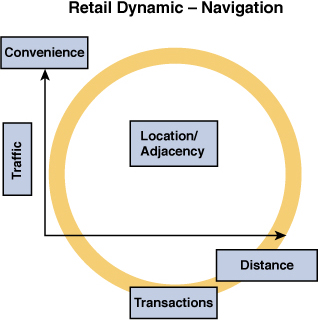
Figure 10.3 Retail Dynamic-Assortment
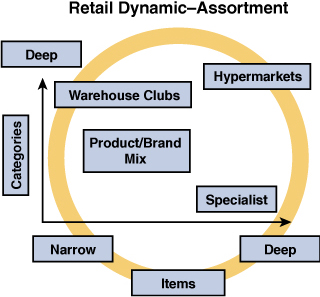
Familiarity is an often overlooked part of retail strategy. The easier we make the shopping experience for shoppers, the more relaxed they will be and the more messages they will see. By extension, the more difficult we make the task, the more fatigued they become, purchasing fewer items. However, we know that shoppers will expend the minimal effort to achieve their objective and, if a store is overly familiar, they will complete their mission on autopilot, editing out thousands of potential stimuli. The result is a shopping basket that has fewer items than it could.
Comfort with a store breeds loyalty and repeat visits. Disruption creates fatigue during the visits and leads to a loss of total shoppers. The proper amount of dissonance introduced into the shopping environment will not fatigue shippers and will intrude on their comfort zone just enough to cause them to notice more items and increase the size of the shopping basket (see Figure 10.4). If the dissonant messages have value to shoppers, they will reward marketers with vastly improved results.
Figure 10.4 Retail Dynamic-Familiarity
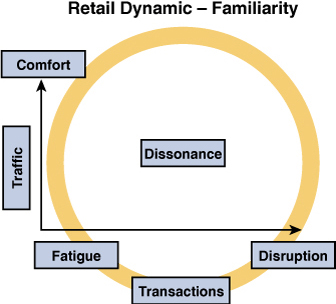
A final tension involves the messages delivered in-store. We know that the proper message delivered in the right place improves results (see Figure 10.5). However, we have to intelligently manage our choice of emotional versus informational messages as a part of our total communication to shoppers. We know that making messages implicit increases their power as shoppers draw their own conclusions, but explicit messages are clearer and minimize confusion. Likewise, complex products require detailed explanation, but the introduction of a number of points to consider decreases our persuasion and conversion as the amount of information offered in store inversely mirrors the sales impact of the information presented.
Figure 10.5 Retail Dynamic-Communication
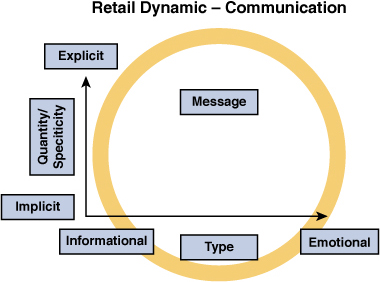
Retail Tools
Our review of the relevant research and a process for developing and implementing strategies leads us to the proposal of ten tools for increasing retail success.
Tool #1—Make a Stand
Trying to be all things to all shoppers is a certain path to failure. Success today and tomorrow will be driven by an identification of the shoppers who are important to you, an understanding of what is important to them, the development of a meaningful brand promise, and the consistent delivery against that promise. Segment the shopper universe, define your market to be served, and work a formal process to attain and maintain intimacy with them (see Figure 10.6).
Figure 10.6 Retail Definition Elements

Tool #2—Operate Within Dominant Shopper Schemata
Understand shoppers’ necessary use of shortcuts, and position your products and messages so they are familiar yet also appropriately interruptive in a manner that is meaningful to the shoppers you target. Work with, and through, the dominant organizing principles employed by your target shoppers in both the physical positioning of product and marketing support and the messages communicated. Strategically, consider the application of all the tools at your disposal against the targeted shopper groups: store entrance, layout, navigation, segment adjacencies, and planograms.
Tool #3—Structure Meaningful Conversations
Approach the time shoppers spend in your store, in your section, and with your brand as a conversation. Understanding what is important to the shoppers you serve in this location, make that conversation meaningful by controlling the amount of information and delivering the desired information in that place at that particular time. Make connections for the shoppers and assist them in their mission to reap the rewards of trial, loyalty, and greater sales.
Tool #4—Use Complementary Merchandising
Part of making connections for shoppers includes an anticipation of related needs. At times the relationship is easily seen and flows from the logical combination of items generally required for a complete experience, as with our examples of hot dogs and buns or cake mix and frosting. At other times, the connections may be mood, occasion, or need-state based. Examples include wine with steak or seafood, beer with brats, or even beer with diapers. Making connections for shoppers, either explicitly or implicitly, increases sales when the connection has meaning to the shopper.
Tool #5—Focus Attention
After shoppers locate an item or area of interest, they are not inclined to remain focused. Instead, their attention wanders, and other potential items of interest enter their field of vision. We can leverage this peripheral exploration with complementary merchandising and intuitive adjacencies, but first we must make sure that we convert their interest into a transaction. To do so we need to make certain that we
• Strategically use signposts to attract shoppers.
• Define the section so that the area for consideration is intuitively understood and we hold the shoppers’ attention.
• Edit the assortment so that the options to be considered make sense and do not overwhelm shoppers, resulting in fatigue or confusion that leads to a decision postponement.
• Present the product choices in a clean planogram that appeals to shoppers, subconsciously and consciously, as attractive and easy to shop.
• Support the product presentation with the marketing at retail messages and tools that appropriately assist shoppers in their decision making.
Tool #6—Use Adjacencies
Shoppers are on a mission during which they screen out nonessential products until they locate a product or message of interest. We must leverage the period in which they shift from browsing/macroscan activity to purchase consideration to first close the sale and then trigger the consideration of additional items. We can use the positioning of related categories adjacent to, or in proximity with, the item of focus to reduce shoppers’ workload. Traffic is a precious commodity, and we need to optimize the value of shopper traffic to create incremental sales by maximizing the value of purchase decision points.
Tool #7—Leverage Brands
Brands have tremendous power. Marketers have spent billions of dollars making implicit and explicit connections between consumer aspirations and their products so that they become powerful shortcuts for shoppers and often define a category. Brand power includes trade dress and the powerful imagery with which they have drawn associations. Brands can
• Influence the choice of channel or retailer
• Draw traffic to an area of the store
• Define a section or category
• Provide additional shopper insight through their extensive research that yields a deep understanding of their consumers
• Increase movement of secondary brands/products
• Deliver emotional power
Tool #8—Choose When to Interrupt Traffic Flow
Our shopping environments need to be comfortable and efficient to attract shoppers and minimize the fatigue that can depress sales. However, we need to protect against the potential for shoppers to move through the stores on automatic pilot mechanically picking up the items on their mental list and never “seeing” anything else. The key is to control the flow and pace of traffic.
First, create spaces to linger so that shoppers are encouraged to mentally slow down, increasing their relaxation that, in turn, enhances their receptivity to more of the stimuli presented in store. Then, create additional opportunities to see and interact with products by selectively interrupting traffic flow in a manner that has meaning to your shoppers.
Tool #9—Execute Consistently
Today’s shoppers move freely across channels and choose widely divergent levels of service and assortment as they seek to complete their shopping needs. An essential factor in their choice of outlet is the consistency of the actual experience with their expectations. Controlled dissonance can increase results by creatively intruding on the shoppers’ consciousness to deliver a message of value. Too much incongruity in the shopping environment requires conscious mental processing that will quickly lead to fatigue and abandonment of the shopping trip. We need to deliver consistently through all levels of design and execution to support the targeted shoppers’ expectations.
Tool #10—Measure and Refine
As intelligent and brilliantly designed and executed as our program may be, it is absolutely essential that we consistently drive our learning and expectations through all the involved levels of our organizations and then measure our results so that we can identify anomalies and improve future results. First, we must create integrated teams so that we draw on all the knowledge available to us to build programs, and then we must share the consolidated learning back throughout our teams. We must establish key metrics and goals for our programs and measure our results with an accompanying interdisciplinary review to discuss successes and failures and identify opportunity areas for future programs. We operate in a period of an ever-increasing pace of change, so we need to constantly refine and enhance our strategy and tactics.
Return on Investment Models
Return on investment (ROI) is critical to the long-term success of our programs and plays a crucial role by establishing the metrics that drive measurement and refinement. On the surface, calculating ROI is a simple matter of measuring direct costs against the direct benefits generated:
![]()
However, multiple levels of measurement complexity exist, depending on
• Participant viewpoint
• Perspective on total returns
• Level of cost measured
Traditional Model
A traditional return on investment model calculation looks something like this:
Expansive Model
Although it is important to understand direct costs and returns, our previous discussions have conclusively shown that retail marketing delivers meaningful benefits well beyond the incremental sales generated during a specific period of time. The POPAI MARI subcommittee expanded the consideration of the total benefits that could be associated with retail marketing efforts (see Figure 10.7) to include1
• Incremental sales
• Incremental profits
• Total market basket impact
• Brand impact
• Choice of manufacturer
• Category impact
• Choice of store
• Channel selection
Figure 10.7 Potential Benefits
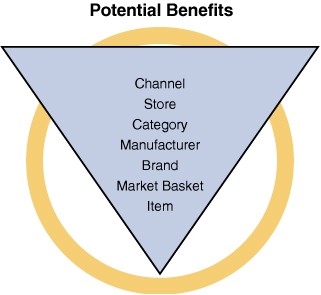
Likewise, the potential costs associated with marketing at retail campaigns extend beyond the direct costs of the material itself (see Figure 10.8) and can include2
• Cost of vehicle
• Cost of goods to support display
• Setup costs
• Disposal cost
• Opportunity cost for space utilized
• Trade allowances
• Distribution cost
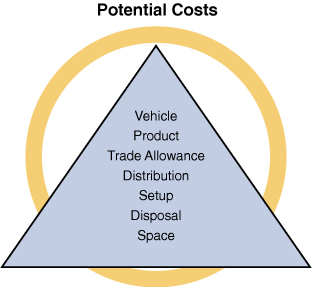
Considering this more robust view of the total costs and returns generated by retail marketing efforts (see Figure 10.9), we end up with this measurement model:
Figure 10.9 Potential Benefits and Costs
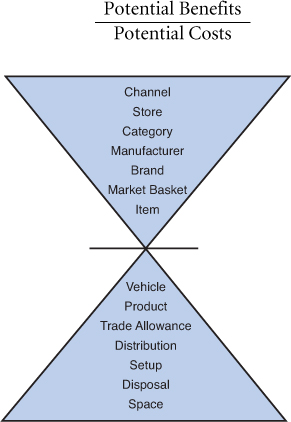
Using these considerations we can mathematically express the ROI from a variety of participant viewpoints, and as either a post-program evaluation tool or a preprogram predictor.
Overall Evaluation Model
The overall evaluation model in Figure 10.10 incorporates all the potential benefits and costs that could be associated with a program for both brands and retailers. The potential benefits include direct sales and the broader, long-term benefits; the cost considerations include direct investments in the marketing at retail activity and the opportunity cost associated with the use of retail space.3
Figure 10.10 Retail Marketing ROI Model

Analytic Retail Model
The analytic models look back to measure the return generated from recently concluded marketing efforts. In the retail model shown in Figure 10.11, we consider the direct and indirect retailer costs and benefits so that we remove the consideration of manufacturer choice and trade allowance costs.4
Figure 10.11 Retail Marketing Retailer ROI Model Without Compliance

Analytic Brand Model
In the analytic brand model in Figure 10.12, we remove considerations of the benefits associated with total market basket size and store/channel selections and those costs which do not accrue to brands, such as opportunity cost consumed by the space devoted to the marketing effort. In developing separate measures for brands and retailers, it is not that the retailer concerns are not important to brands and brands scorecards are not important to retailers. Rather, it is important to have a clear measure of the returns our efforts generate against our own financial report cards.5
Figure 10.12 Retail Marketing Brand ROI Model

Retail Model
Our predictive models look forward to forecast expected results for proposed marketing programs based on our experience and analyses of previous programs. The overall predictive model in Figure 10.13 introduces the consideration of the expected level of field implementation for the campaign (compliance). All our anticipated benefits are modified by the percentage of displays actually executed in store. On the cost side, all our costs remain except those related to setup and opportunity costs. The completion of predictive models in concert with program development can establish important markers for evaluating the success of programs at their conclusion.6
Figure 10.13 Retail Marketing Retailer ROI Model with Compliance

Achieving Success Through Shopper Intimacy
Profound changes are shaking our retail world. These changes are driven by a combination of macro societal changes in shopper composition, attitude, and empowerment, the implosion of traditional media models, and tectonic shifts in the retail landscape. Concurrent with these macro changes, an explosion of research into shoppers’ behavior at retail has produced and continues to generate a tremendous number of insights that dramatically raise the level of available knowledge. This increased knowledge has implications for all retail marketing participants. For thought leaders, the research opens significant new opportunities for unlocking increased growth and profits, whereas a failure to properly employ the data will leave others with outdated models that deliver declining returns.
Today’s winners recognize the opportunities that the market changes and new information provide, and they build programs that position themselves for sustained growth by implementing a process that routinely translates their data into shopper intimacy and then drives this knowledge throughout their organizations. They create a cycle in which they analyze data to develop the insights that inform a targeted, shopper-focused strategy that incorporates the key objectives of all participants. Their strategy is then implemented with subsequent measurement and analyses of the results in a search for additional insights that will improve future plans.
This virtuous cycle of regularly translating new information into actions and analyses that culminates in intimacy is centered on the optimization of retail space productivity and the effectiveness of marketing budgets, as shown in Figure 10.14. Shopper intimacy ultimately drives the key decisions we make about whom we target, the tools we employ to reach them (what), when we seek to engage them, and the messages we utilize (how).7
Figure 10.14 Retail Marketing Effectiveness Cycle

Optimization of retail performance depends on the achievement of shopper intimacy developed and implemented in a collaborative process that unites the key participants in the pursuit of shared goals (see Figure 10.15). Each participant must direct their efforts on servicing a particular shopper and meeting her needs in a particular place. By bringing their unique insights together, brands, retailers, and agencies increase the value of their analyses. By understanding the needs of each constituency and appreciating the points of convergence and divergence, participants increase the quality of their strategies and the level of implementation for their programs.
Figure 10.15 Integration and Collaboration
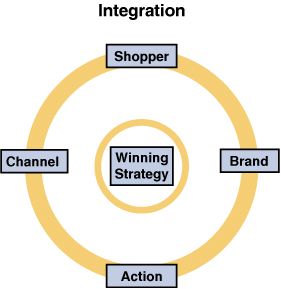
Although the benefits of this knowledge-based, integrated approach are immense, the level of change for participants in retail marketing and their organizations is massive. The development of the store as a medium will lead to increased awareness of retail marketing and spur greater innovation that will, in turn, stimulate the development of new vehicles while increasing the premium for insight and creativity. Greater agency involvement will accompany a shift of media dollars into the retail arena with the underwriters demanding accountability and reliable metrics. Increased collaboration and the inclusion of new players in the planning mix will lead to a redefinition of roles, the development of a common language, and eventual agreement on general principles and methodologies.
Retailers will face difficult decisions on the allocation and use of space that will affect assortment choices. Demand will grow for reliable compliance reporting for planned programs. Brands will reallocate their marketing dollars and merchandising roles will change dramatically as the focus of retail presentation grows to include a broader spectrum of brand communication goals. Agencies will heighten their involvement as discussions become increasingly strategic with an expanding search for innovation.
As practitioners grow in sophistication, they will resolve the organizational tensions in the current structures that arise from divergent focal points by concentrating on the mutual gains that accrue to the teams that direct their attention on shoppers’ needs.
Organizational Tensions

The end result will be a deeper understanding of shoppers in retail stores and increased space productivity as we collectively do a better job of anticipating and meeting shoppers’ needs. As information and understanding become increasingly available, we increase the opportunity to improve returns by applying greater efficiency throughout the process of reaching and servicing consumers and shoppers. Internally, our dialogue becomes increasingly strategic as a prelude to a similar elevation of the discourse that expands to include all key participants.
The process detailed in Figure 10.16 begins with an acknowledgment and acceptance of the changed environment in which we now operate. This acceptance leads to an aggressive search for data that we can translate into insights that inform our development of targeted strategies and action plans that include all the key stakeholders. We then gather the resources needed to implement the plan and analyze our results against the key metrics established for our program to unlock new insights that lead us to an intimacy with the shoppers we target. The integration of process and data in an inclusive cycle of continuous testing and refinement will drive consistent improvements in sales and productivity.
Figure 10.16 The Path to Shopper Intimacy
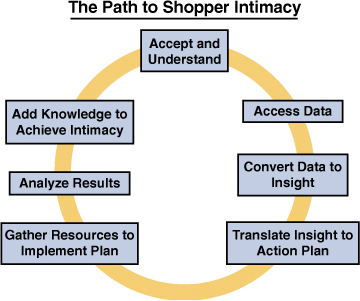
Endnotes
1. Authors’ notes (December 2006).
2. Ibid.
3. Ibid.
4. Ibid.
4. Ibid.
5. Ibid.
6. Ibid.
7. Ibid.

